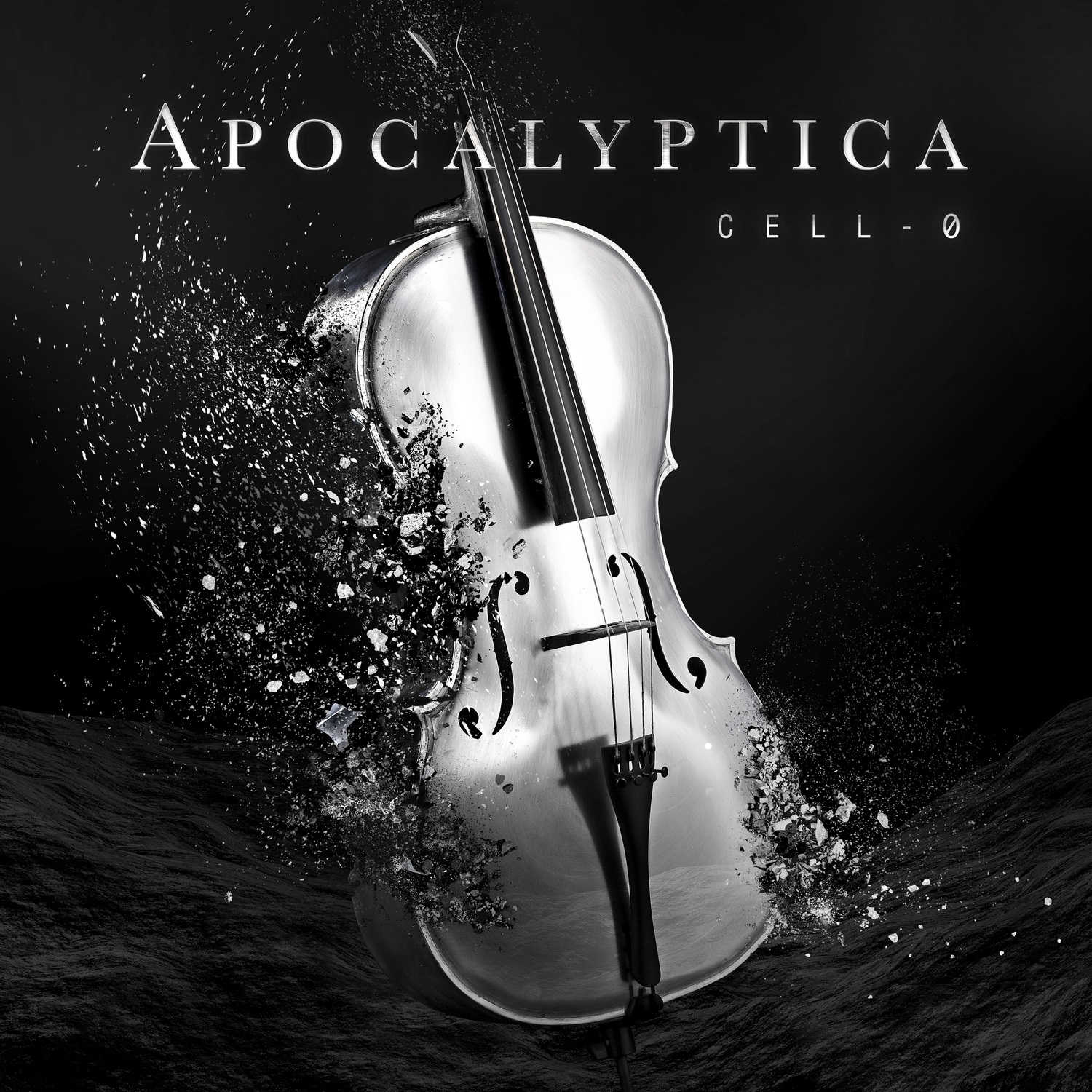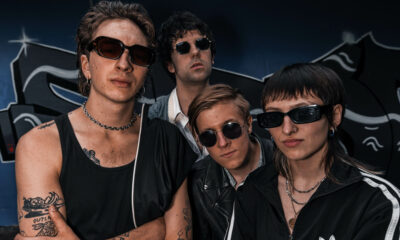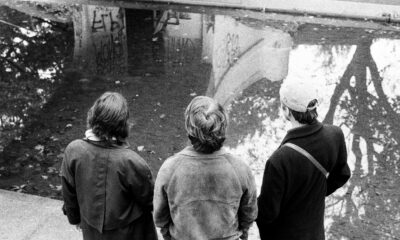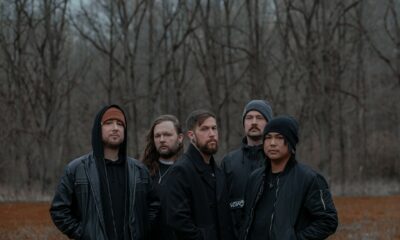Interviews
APOCALYPTICA Bass Celloist Paavo Lötjönen Discusses The Band’s Latest Record ’Cell-0,’ the Influence of Metallica and Being an Instrumental Band
In preparation for the release of their ninth studio album, Cell-0, we spoke with Apocalyptica member Paavo Lötjönen about the new record and Apocalyptica’s rise to fame, including their influencing of Metallica’s S&M record.

Apocalyptica have been at the forefront of the metal movement since their inception, in the form of a Metallica tribute album, Plays Metallica by Four Cellos. This sparked a worldwide surge in popularity, and countless collaborations with similarly high-profile artists such as Corey Taylor, Ville Vallo, and Till Lindemann. Now, they are set to release their ninth studio record, Cell-0. After having a skiing holiday in Austria, Paavo Lötjönen sat down with us for a chat prior to the end of 2019 about all things Apocalyptica, Cell-0, and how they inspired Metallica to create their unique symphony record, S&M.
You’ve got your new record coming out in January. How does it feel to be back in the studio after four years since Shadowmaker?
Paavo Lötjönen: “You know, we have been really busy all these years, the last five years. First, we released Shadowmaker and then we started touring with that. The tour was about two years, and immediately after that we released this 20-year anniversary Plays Metallica album once again, and then we started to tour with that. With the Apocalyptica Plays Metallica tour, we had 240 shows in 47 countries, and it took like 32 months to complete. A lot of playing around the world. Even the release cycle is really slow if you think about that, the Shadowmaker album. We’ve been working constantly and playing shows around the world, so we have not been lazy!“ (laughs)
Not at all!
Lötjönen: “We recorded this new album last January, February, March. We already started to compose that in the autumn side (of the) previous year. So, even we had this Plays Metallica tour going, we took three months break and recorded this album in Helsinki. Actually, it was quite a fast process. The composing itself was a bit slower, but the recording we did it in one and a half months, and we decided to do that in Helsinki because we didn’t want to go abroad and stay away from our families at that time.
We wanted to produce this by ourselves this time. We have had really fantastic producers on previous albums, you know, producers many times, they always try to offer their own format on the songs. This reminds me about the process of (the) Cult album, which we mainly did, like, an Apocalyptica album which we made mostly ourselves and produced that. This time, we just had one recording engineer helping us, Joonas Parkkonen, he’s a really good musician himself as well, and he’s really super fast with recording and good ears. So, he was like an assistant producer in the recording process and tracking the songs. So, you know, when you are recording the album there is tons of work with all those files and getting them cleaned. It’s really like a technical job and not really creative, so we wanted to get creative by ourselves and leave the boring technical stuff for Joonas.“
Watch Apocalyptica’s latest music video for “En Route To Mayhem:“
Just give him that job.
Lötjönen: “A fair deal. (laughs) But he was paid his salary for that!“
Lets you guys have free reign!
Lötjönen: “Yeah. Still continuing with this theme. The starting point for this album was that we wanted to create like a special item for hardcore Apocalyptica fans who love the instrumental Apocalyptica music. We know that you know, these times, it’s kind of economical suicide to release instrumental music. No radios will be playing that, and even for streaming, it could not be hit material. But we wanted to target this album for music lovers and Apocalyptica fans who really love our instrumental worlds and create mindscapes and musical paintings for our core audience. It’s a different approach to compose instrumental music than to create radio-play songs. You know, if you want to have a radio play a hit song, or whatever song which will be played in the radios, you need to have chorus, verse, chorus, verse, structure on the songs. Most radio play songs have it like that. We didn’t want to be stuck on this.
If you listen to our songs, I would not call them songs. They are more a compositional piece of music. Tracks! They are really progressive, the structures are really different every time; some of the songs are over ten minutes long, and some could be even symphonic with progression inside the song. Combining the singing tracks and the instrumental music, we’ve always felt it’s kind of tricky and difficult thing, because it’s not good for instrument music, it’s not good for vocal tracks. This time, we wanted to just have an absolute abstract instrumental music which creates feelings and memories, like pictures in our audience’s mindscape. You know, this will be released January 10th next year, in one month. Later next year we will release some singing tracks as well. Those singing tracks, where we have guest vocalists, they are totally different songs, so we don’t make a new version of these album songs, they are new songs. So yeah, that’s all for now!“
For the most part, a lot of your really popular songs have featured guest vocalists and had guest vocals from Corey Taylor, etc… This time, it’s all you guys, doing what you want to do, and I suppose that made the process more natural?
Lötjönen: “Of course, yeah. To be honest, if we are talking about the guest vocalists, it’s a nightmare for, especially our manager and those who are working in our management, trying to fit all the other record company’s times and schedules and deals and releases schedules, that’s a nightmare! We are talking about international rock stars and their schedules; it’s not really easy to fit everything together. We also really had a couple of bad examples in the past (of) what could happen with songs with release dates, you know. We were totally free from that stress this time.“
The focus on soundscapes is quite mesmerizing on record. I was wondering if you could talk through some of the themes or emotions you wanted to go through whilst creating the songs?
Lötjönen: “You know, all the songs, all the tracks, they have like an individual creative story, of course. Some of the songs had some idea, early in the beginning process, that it had some theme or name to tell about it. Like on ’Call My Name,’ it has a really strong story behind, but some of the songs are absolute instrumental music, without the story or lyrics, no existing lyrics, there was no story behind it. Just music creating from zero. Of course, when we had all the tracks recorded and we had some ideas and some creative ideas already for some songs, we wanted to combine the songs somehow together. Of course, giving the name for the song, it’s one way to get the theme more focussed in a certain direction. Of course, we need to talk bullshit about the music to create a story and some kind of explanation for the music!
We also created, kind of, stories, behind this music. To be honest, for myself, I wouldn’t explain too much of the music for the listeners. If you listen to some track, you should close your eyes and create your own mindscape. What does it bring to you? I would say these tracks are quite complex and difficult music. They don’t open really easily. So, you should listen to them a couple of times to really sort it out what’s happening in there, and you should start painting your mindscape and own picture. Everybody will do a different picture when they are listening to those songs, and I think it’s fantastic because there are no lyrics to tell the stories behind the secret emotions. Everybody will create their own picture of the songs. Of course, the topic and name of the song is a kind of guideline and it roughly shows the direction (of) what could it tell about, and of course, our bullshit talking here (laughs) could explain some more and tell some more ideas of what it could tell.
For the whole album, I would say it’s a reflection of our time. Quite strongly. About all the angst and bad feeling about what’s happening around us. Our politics is from time to time, really bullshit, and environmental things… we really live in a strange time. At the moment, maybe the media has done it, but it feels really apocalyptic at the moment with all the environmental things. We are really living on the edge of those times; can we really do anything anymore? We don’t want to save the world, we’re maybe the worst people to do that because we are traveling around the world and polluting it, but we still need to try to do our share and make people think about it, what they could do better.“
Apocalyptica’s ninth studio album Cell-0 was released January 10th, 2020, via Silver Lining Music:

That’s the best thing you can do with a track, especially if it’s instrumental. You’re letting people make their own inferences without necessarily giving it to them on a plate. You can let people create their own ideas from it.
Lötjönen: “Yeah. We’re human beings, we need some kind of uplift and escapism from time to time. Art, movies, books, good music makes that uplift, and we need something to dream about and have different dimensions in our mind.“
Especially with music as powerful as yours instrumentally, it can make a change in perspective. If you’re listening to music which is emotional and it gives you quite a strong message, regardless of what that message is, it can make a change and inspire you. You were mentioning earlier that the production process was quite simple, but you also mentioned the songs are quite complex which they definitely are. I was wondering how long it takes for the base idea for a song to turn into its final form?
Lötjönen: “Some of the songs were created really fast, and some of the songs took months and months. But, this time, we didn’t sit down in a rehearsal room for months. Most of the songs were created alone in a working room, doing the demos with a computer and Logic files and sometimes playing on the top of Logic files. Then, we presented that to each other, and then we were listening, ’Could it be a good song?,’ but we didn’t start to practice or rehearse them and rearrange the songs. We had some comments on what should be changed on the song and what should not. Some songs were totally kicked out, they were not working, or the point was missing.
Then, when the demo was good enough, we went into the studio and we started recording, of course at that moment there were always some changes made on the recording. So basically, the final arrangement was made in the recording room. I would say that tracking itself I would say took like two days per song or four days per song. It depended. Some of the songs we recorded for five days, because, you know, some of the songs are over ten minutes long, so there’s a lot. All that time, you could record like three pop songs!“ (laughs)
(laughs) There’s a lot more to it!
Lötjönen: “Yeah, yeah. So, some of them were more difficult than others. We were like cursing in the studio that we composed too difficult music, too difficult playing! There are some songs with really difficult riffs and the time codes. If you think (of) the (track) ’Fire & Ice,’ I would pay you £100 if you could write the riff track in ten minutes!“ (laughs)
Oh, I definitely would not be able to do that! (laughs)
Lötjönen: “If you could even sing that riff, it would be fantastic. I’m practicing that at the moment. When we finish this interview, I’ll go downstairs and take my cello to play that riff. Oh, it’s really difficult! Let’s see what will happen in January!“ (laughs)
When you’re touring?
Lötjönen: “Yeah, we will start touring with Sabaton in January and February. But, March, we will start playing our own shows in Finland, and then we go to the U.S., and later next year we will come for a European tour for our own tour. Then, we’ll play most of the new album songs.“
Also off of Cell-0, watch the music video for “Rise:“
When you tour, you do so quite extensively. Like you said, you were touring for 32 months. Don’t give yourselves much of a break! How do you keep yourself going when you’re on the road and do you have time to practice every day?
Lötjönen: “Yes, we should practice more! (laughs) You know, normally we try to have four weeks on the road as a maximum, or five weeks is a maximum on the road. Then we come back home for recovery and resting and doing some other life. On the tour, we try to have five to six shows a week, so it’s really intense touring time with us. Every day, there’s always a soundcheck (which) takes one hour, then there’s a show for almost two hours. So, there’s three hours playing every day. For a cello player, three hours a day is not much, but still, it helps to keep your fingers in a good shape!
To be honest, if we play those hard riffs, it’s quite far away from a classical cello playing technique. It’s really special. You play many times in fifths, you play two notes at the same time, it’s really rough for your fingers and joints. So, we were suffering, fifteen years ago we were suffering that our fingers were not strong enough. Nowadays, we are made of steel (laughs) so we have more power to withstand that kind of playing. But, you know, you need to take care of yourself. We go jogging and we go to the gym and gymnastics every day, and nowadays we are quite boring in this rock n’ roll life, we don’t party too much! Actually, even the alcohol, really little, poorly. That’s poorly rock n’ roll life, in that sense.“ (laughs)
In that sense, maybe, but you’re also 23, 24 years into your career starting off as a Metallica tribute, and now traveling the world!
Lötjönen: “Yeah, we feel alive. Time to time we feel that it’s a battle, but we feel alive. In the past, there have been moments with a lot happening when you’re on tour, but luckily, we are alive here!“ (laughs)
Onto the subject of that, if you can remember a specific moment that Apocalyptica wasn’t just another band that started up, it was actually becoming world-famous?
Lötjönen: “If we go back, like 20 years back. All this Apocalyptica project started, you know, we were friends, we wanted to play some fun music together. We didn’t have any plan, we didn’t have any kind of aim to get the success. We didn’t aim to have a career, it was really spontaneous and natural, just having fun together with friends. And, after a couple of shows, when we had just played for fun at student parties and some of our friends came to us to say that we should do an album, we were laughing for them. But, with this first album, one record company guy came to us and asked for an album, and we were thinking like, he must be crazy, let’s see what will happen.
So, the first album was just like a project, interesting project, to see if we can sell 1,000 copies and get the recording costs away and maybe play a couple of shows, that’s it. But suddenly, it became a huge success and was released all around the world and it sold like, nowadays it’s sold almost two million copies. Then there came some more requests for the shows, another album, more shows. So, everything came step-by-step, but we never had a kind of master plan what to do in the future, (so we thought) “Let’s see what does it bring to us.” Of course, we have been really surprised for everything that has happened, and of course thankful. We have been living with this for 20 years and making quite an ok living. I’ve paid my house and have raised three kids at the same time, yeah, thankful. We are not millionaires, but we’ve been living, we’ve been lucky bastards!“ (laughs)
Living a great and comfortable life. Definitely a reward.
Lötjönen: “But, you know, of course, there were times when it was really rough. I remember the third album or fourth album, we were still playing quite small shows, traveling around Europe with a small van and station wagon car, driving ourselves. That was a hard time because it really couldn’t earn good money for a band playing shows (like that). Suddenly, we’ve succeeded to turn it more successful. Now, we have fantastic audiences and play at pretty ok venues and it’s pretty motivating. It’s been like, I would not change that. I think we have been really, how do you say, privileged.
I can imagine how difficult it is for newcomer bands nowadays. We couldn’t earn any money playing shows around Europe, or it was really lousy money. But you earn some money from the record sales, and we made our living off that. But nowadays when there are no record sales, and there’s no money coming out from the streaming, it’s really rough, really hard for the newcomer bands.“
Check out some more from Cell-0, with the music video for “Ashes of The Modern World:“
It’s a completely different environment nowadays, isn’t it?
Lötjönen: “Totally, yeah. Records is not a business anymore. Only if, you know… somebody tells the stories that some big names earn some money off the stream, but I’ve not seen that money! Of course, we think we are still marginal music. That does not bring the big streaming monies for us.
I think your approach to rock and metal is very unique. You basically started a genre within metal, string metal, or cello metal.
Lötjönen: “I remember like ten years ago, if you went to East Europe, like Poland or Czech or whatever Eastern European country, almost every city had one cello group playing some rock music. I think that’s hilarious. Of course, we were really proud of our effect and what we have created. Of course, Two Cellos is extremely successful, they are playing AC/DC and these kinds of pop songs, you know that? They are really successful. They have seen our shows when they were like teenagers. They started to do the thing we refused to do. When we did the third album, we were asked to do an AC/DC and one more cover album, we said that we have done this cover thing already with two albums. If we start to play ’Thunderstruck’ with cellos, it’s too cheesy for us. But, you know, Two Cellos, they did it successfully, they’re really good cello players. I’m happy they’ve done so well.
But, I guess, we started at the time when there, maybe one year after us, Nightwish came with the opera singer kind of voice. I guess it was something also, because we had the classical metal door open already, and after that, this classical world came totally strong with metal music. Then, there have been tons of metal bands with an opera singer. Also strings and orchestras, like classical elements combined to metal music. Even Metallica made this S&M album after our album. They say… the Metallica guys, they said we were one of the inspirations and we were encouraging them to do S&M.“
That must have been a crazy feeling…
Lötjönen: “Yeah, actually they invited us to San Fransisco to the premiere and recording. They said that we were one of the reasons why they were brave enough to do that, finally!“
To have something like that from Metallica is quite something. We’re running out of time. My last question was going to be about highlights of your career so far, and I would assume that’s probably one of them?
Lötjönen: “The starting highlight. Our fifth and sixth show was to open the evening for Metallica in Helsinki. That was a starting point. We’d just released our (first) album, and our fifth show was supporting Metallica! (laughs) After that, of course, we have played almost 2,000 gigs around the world. There’s really many great concerts. Of course, those huge, open-air stages, like Wacken Open Air main stage for 80,000 people, it’s always memorable. In Canada, we played for 100,000 people, Mexico City last year we played for 65,000 people. That kind of huge mass of audience is… of course, it’s always a great feeling. But, you know, our philosophy is that every show, we are performing for individual people. It doesn’t matter if there’s 400 people or 40,000 people; we try to give the best possible concert for every audience, every time. Maybe that’s one of the reasons we’re still existing. That there is no basic difference with the audience if it’s small or big. You know, there’s always individual people, and we try to reach their heart and soul.“
Watch Apocalyptica perform the Metallica classic “One“ with this live music video:
It’s so important to establish that relationship with the audience.
Lötjönen: “You know, we are not doing the show alone. We are doing that together with the audience. You always need that sort of interactive feeling. You need to reach the people and watch their eyes and get the connection. You know, music itself, it’s an energy. We are transmitting the energy from music from us to them, and they also give the best possible thank you for us by connecting themselves to us as well. That’s the best price for a good show! We are connected to the people.“
Must be an amazing feeling.
Lötjönen: “That’s always good. It’s a kind of act of love between all of us. Music unites!“
It does! Sometimes it sounds cliche to say it, but it really does. When you’re in a venue full of people playing music, they love and listening to music that they love, there’s a very powerful and strange energy.
Lötjönen: “That’s the reason we go to the live shows. That’s what we want to get from there.“
Absolutely. I’ll wrap this up now, thank you so much for talking. I was wondering if you wanted to say anything to promote your album your tours before we end?
Lötjönen: “You know, even we play this kind of support gig in January with Sabaton, we will play there a couple of new songs already, like a combo of new songs and old songs. But, later next year we will play more of this album, Cell-0, tracks. We have already been designing the new shows with visuals and projections and a lot of visual things. It will be like a musical trip, which you should see alive.“
-

 Music7 days ago
Music7 days agoTake That (w/ Olly Murs) Kick Off Four-Night Leeds Stint with Hit-Laden Spectacular [Photos]
-

 Alternative/Rock20 hours ago
Alternative/Rock20 hours agoThe V13 Fix #011 w/ Microwave, Full Of Hell, Cold Years and more
-

 Alternative/Rock1 week ago
Alternative/Rock1 week agoThe V13 Fix #010 w/ High on Fire, NOFX, My Dying Bride and more
-

 Features6 days ago
Features6 days agoTour Diary: Gen & The Degenerates Party Their Way Across America
-

 Culture1 week ago
Culture1 week agoDan Carter & George Miller Chat Foodinati Live, Heavy Metal Charities and Pre-Gig Meals
-

 Music1 week ago
Music1 week agoReclusive Producer Stumbleine Premieres Beat-Driven New Single “Cinderhaze”
-

 Indie20 hours ago
Indie20 hours agoDeadset Premiere Music Video for Addiction-Inspired “Heavy Eyes” Single
-

 Alternative/Rock2 weeks ago
Alternative/Rock2 weeks agoThree Lefts and a Right Premiere Their Guitar-Driven Single “Lovulator”
















